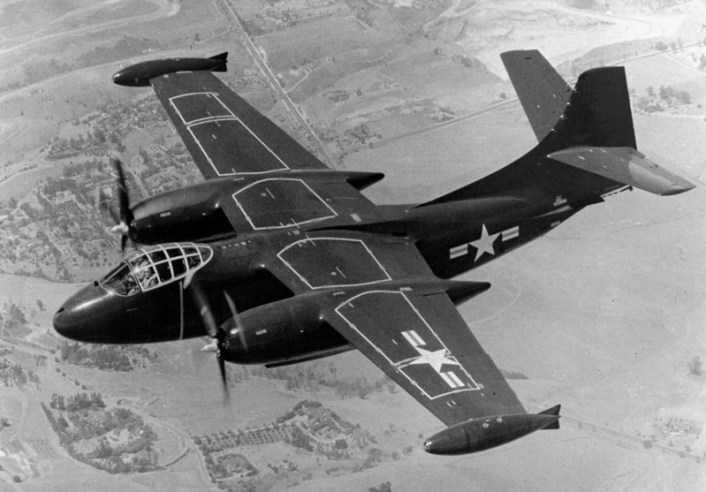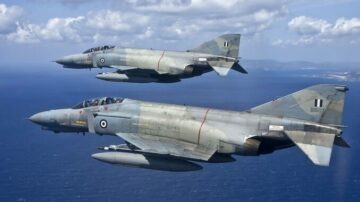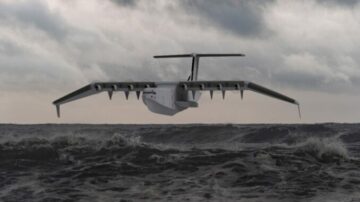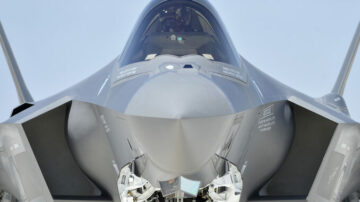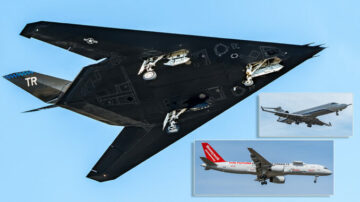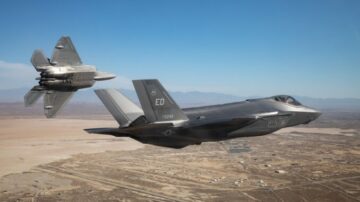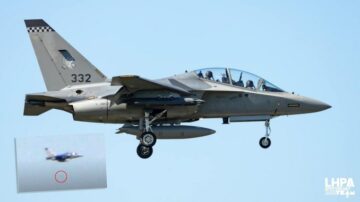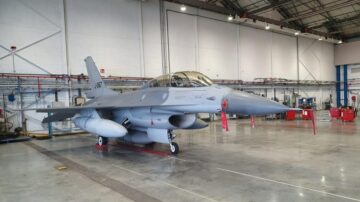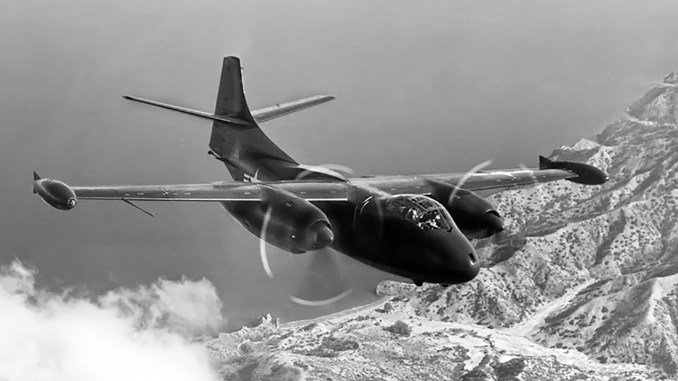
After the Birth of the USAF, the AJ Savage Was the Navy’s Struggle for Relevance in the New Atomic Age.
Sleek, pretty and reportedly a dream to fly, the obscure North American AJ Savage nuclear strike aircraft may be one of the most significant aircraft you’ve never heard of. But the AJ Savage is worth knowing about.
The AJ Savage could actually be one of several reasons why we still have a carrier fleet in the U.S. Navy today following the nuclear strikes in 1945 and the creation of the U.S. Air Force in 1947.
In 1945 the global strategic order had just been upended by two operational strategic nuclear strikes on Japan. The bombing of Nagasaki and Hiroshima revolutionized the role of airpower in warfare and global diplomacy in a nuclear flash. These events, and the long process that lead up to them under deep cover of secrecy, shifted warfare to perhaps a greater degree than any event since early men hurled a stone at an adversary.
Suddenly, airpower was more relevant than ever. Strategists and pundits made a case that the need for a navy was eliminated by the Air Force’s nuclear strike capability, a tool that would dominate the upcoming Cold War era into the next century and into space.
In its struggle for relevance, the Navy needed to develop a comparable nuclear strike capability. The newly formed U.S. Air Force had the B-29 and B-50 Superfortress nuclear strategic bombers. The gigantic Convair B-36, nicknamed “Peacemaker”, was soon to leap off the drawing board as the largest strategic bomber ever built. With their new “big stick” arsenal, the U.S. Air Force set out to establish new range and endurance flight records that proved American bombers could strike anywhere in the world from bases in the United States.
In July 1948, the U.S. Air Force used Boeing B-29 Superfortress strategic bombers to complete a global circumnavigation in only 15 days with 8 refueling stops. It was an impressive achievement of aerial range and endurance. But only 7 months later, the U.S. Air Force made an even more remarkable strategic statement by completing a non-stop global circumnavigation flight relying entirely on aerial refueling. The U.S. Navy had been put on notice to maintain their relevance in the new nuclear Cold War.
One contribution the naval aviation community made to the emerging U.S. nuclear delivery capability was the North American AJ Savage.
The AJ Savage was an elegant twin radial piston engine propeller driven and single jet engine bomber that first flew on July 3, 1948. Intended to fly from the decks of America’s newest, largest aircraft carriers, the Savage’s dedicated mission was strategic nuclear strike. She went on to fill a reconnaissance and aerial tanker role also.

The entire concept of the AJ Savage and the new, fleet aircraft carriers with larger flight decks was at the cutting edge of the see-saw battle between the Air Force and Navy for allocations from the recently slashed U.S. defense budget. The complex role of politics in its emergence aside, the AJ Savage did manage to obtain funding and become operational with U.S. Navy Fleet Composite Squadron 5 (VC-5). The unit made its first deployment from Naval Air Station Norfolk on the U.S. east coast in February, 1951. In total, North American Aviation built about 143 AJ Savages across all variants.
Because the AJ Savage was such a large aircraft, about the size of the WWII B-25 Mitchell bomber, its presence onboard U.S. aircraft carriers was disruptive. As soon as the aircraft trapped at the back of the flight deck, the wings had to be folded. This normally quick process on other aircraft was made more difficult on the AJ Savage because deck handling crews had to climb up, on top of the wings of the still-idling aircraft, propellers spinning and generating significant prop-wash. Then they used a manual pump to fold one wing at a time. Once the two wings were folded, the AJ Savage could be towed to a parking spot on an already crowded flight deck. Before the aircraft could be stored in tight hangar spaces, its vertical stabilizer also needed to be folded downward, another manual process. It’s interesting that the similarly sized B-25 Mitchell bomber was used in the first carrier-based airstrike on the Japanese mainland during WWII in the famous Doolittle Raid on April 18, 1942. It was a strategic bombing strike that foreshadowed the logistical challenges of deck-handling large aircraft like the later, postwar AJ Savage.
Because of the disruption and complexity of deck handling, storage and logistics while onboard an aircraft carrier, the concept of deployment for the AJ Savage was to fly it from the U.S. to foreign land bases. Then, just prior to mission generation, the aircraft would fly from a land base at a forward area to its mission launch point onboard an aircraft carrier. The carrier could steam close enough in-theater to potential nuclear targets that the AJ Savage could then launch from the carrier and easily reach designated targets behind the Iron Curtain in little time. Upon return, the aircraft could conceivably recover aboard an aircraft carrier. However, plans also included ditching the aircraft at sea and recovering the flight crew (presumably) via air/sea rescue assets. This pre-deployment capability for a nuclear strike asset that did not rely on local bases or overflight permissions gave U.S. strategic planners a new tool with significant flexibility.
Because the AJ Savage was still restricted by the performance limitations of a propeller driven aircraft, even though it also had a small jet engine, it needed to loft-bomb a nuclear weapon by approaching its target at low altitude to avoid detection and escape the blast. After its low-level approach, the aircraft would then pitch up to near-vertical and release its nuclear weapon while still climbing. At the top of the release point, once the weapon was gone, the AJ Savage would roll back to a dive attitude and turn its tail toward the nuclear blast while putting as much distance as possible between itself and the nuclear shockwave.
The AJ Savage’s operational career was typically short during this period of rapid aviation evolution. In addition to its mostly Atlantic fleet deployments, it was deployed to the Korean theater of operations on March 5, 1953 aboard the aircraft carrier USS Oriskany (CV/CVA-34). Once in the Korean theater, the aircraft served as a nuclear deterrent.
The AJ Savage skirted history several times, but never managed to carve out its own headlines in the history books to any sensational degree. A tanker version of the AJ Savage refueled pilot John Glenn during his record setting transcontinental supersonic flight on July 15, 1957 in what was termed, “Project Bullet”.
Since the AJ Savage bridged the evolutionary gap between piston-engine, propeller-driven carrier-based aircraft and all-jet aircraft, it was one of a few hybrid aircraft that had both piston engines and a well-integrated jet engine. The General Electric/Allison J-33 jet engine was mounted inside the fuselage. The engine intake was a triangle venturi on top of the fuselage that was covered by a folding door when the engine wasn’t in use. The exhaust opening was underneath the tail. While the small, early J-33 developed only about 3,900 pounds of thrust (for a gross takeoff weight of 50,954 lbs.), it was enough thrust to keep the aircraft in the air on its own. Author Steve Ginter recounted an occasion when one AJ Savage pilot entertained a flight of fighters by shutting down both piston engines in flight, feathering the props, and maintaining level flight on only jet thrust.
Only one AJ Savage remains. She is at the National Naval Aviation Museum in Pensacola, Florida. As of the last Google Earth satellite imagery of the museum grounds, dated 2024, the aircraft is sitting outside in either a large storage area or air park display. So it would seem that the relatively anonymous artifact she has become somehow appropriately mimics her entire career, a noteworthy but little known service life.
- SEO Powered Content & PR Distribution. Get Amplified Today.
- PlatoData.Network Vertical Generative Ai. Empower Yourself. Access Here.
- PlatoAiStream. Web3 Intelligence. Knowledge Amplified. Access Here.
- PlatoESG. Carbon, CleanTech, Energy, Environment, Solar, Waste Management. Access Here.
- PlatoHealth. Biotech and Clinical Trials Intelligence. Access Here.
- Source: https://theaviationist.com/2024/03/22/the-north-american-aj-savage-nuclear-attack-bomber-is-largely-forgotten-but-a-story-worth-knowing/?utm_source=rss&utm_medium=rss&utm_campaign=the-north-american-aj-savage-nuclear-attack-bomber-is-largely-forgotten-but-a-story-worth-knowing
- :has
- :is
- :not
- $UP
- 1
- 125
- 15%
- 1947
- 1951
- 2024
- 5
- 50
- 7
- 8
- 800
- 900
- a
- About
- achievement
- across
- actually
- addition
- advanced
- adversary
- After
- age
- AIR
- Air Force
- aircraft
- All
- allocations
- already
- also
- American
- an
- and
- Anonymous
- Another
- any
- anywhere
- approach
- approaching
- appropriately
- April
- ARE
- AREA
- Army
- around
- Arsenal
- articles
- AS
- aside
- asset
- Assets
- At
- attack
- attitude
- author
- avatar
- aviation
- avoid
- back
- base
- Battle
- BE
- because
- become
- been
- before
- behind
- being
- between
- birth
- board
- Boeing
- Books
- both
- bridged
- budget
- built
- business
- but
- by
- capability
- Career
- carriers
- case
- Century
- certifications
- challenges
- climb
- Climbed
- Climbing
- Close
- Coast
- cold
- College
- COM
- community
- company
- comparable
- complete
- completing
- complex
- complexity
- concept
- continents
- contribution
- could
- cover
- covered
- creation
- credit
- crew
- crowded
- curtain
- cutting
- cycle
- dated
- Days
- deck
- decks
- dedicated
- deep
- Defense
- Degree
- delivery
- deployed
- deployment
- deployments
- designated
- Detection
- deterrent
- develop
- developed
- DID
- difficult
- Diplomacy
- Display
- Disruption
- disruptive
- distance
- dive
- dominate
- Door
- down
- downward
- drawing
- dream
- driven
- during
- Early
- earth
- easily
- East
- east coast
- Edge
- either
- eliminated
- emergence
- emerging
- Engine
- Engines
- enough
- Entire
- entirely
- Era
- escape
- establish
- Ether (ETH)
- Even
- Event
- events
- EVER
- evolution
- experience
- experienced
- famous
- Feature
- February
- few
- fighters
- fill
- First
- Flash
- FLEET
- Flexibility
- flight
- florida
- following
- For
- Force
- Ford
- foreign
- forgotten
- formed
- Forward
- from
- FT
- funding
- gap
- gathering
- gave
- General
- generating
- generation
- Georgia
- Global
- gone
- Government
- graduate
- greater
- gross
- grounds
- Guard
- guide
- had
- Handling
- Have
- Headlines
- heard
- henry
- henry ford
- her
- highest
- his
- history
- holds
- honor
- However
- HTTPS
- Hybrid
- impressive
- in
- included
- includes
- inside
- Insider
- Intelligence
- intended
- interest
- interesting
- into
- IT
- ITS
- itself
- Japan
- Japanese
- John
- journalism
- journalist
- jpg
- July
- July 15
- just
- Keep
- Knowing
- known
- Korean
- Land
- large
- largely
- larger
- largest
- Last
- later
- launch
- lead
- Leap
- Level
- Life
- light
- like
- limitations
- little
- local
- logistics
- Long
- Low
- made
- magazine
- mainland
- maintain
- maintaining
- manage
- managed
- manual
- many
- March
- max-width
- May..
- Media
- member
- Men
- Michigan
- mighty
- Military
- Mission
- months
- more
- most
- mostly
- much
- Museum
- nagasaki
- National
- Need
- needed
- never
- New
- Newest
- newly
- next
- normally
- North
- noteworthy
- Notice..
- nuclear
- obtain
- occasion
- of
- off
- on
- Onboard
- once
- ONE
- only
- opening
- operational
- Operations
- or
- order
- Other
- out
- outlet
- outside
- own
- Park
- parking
- performance
- perhaps
- period
- permissions
- photo
- photographer
- pilot
- Pitch
- plans
- plato
- Plato Data Intelligence
- PlatoData
- Point
- politics
- possible
- potential
- pounds
- presence
- press
- pretty
- Prior
- process
- proved
- publications
- published
- pump
- put
- Putting
- Quick
- raid
- range
- rapid
- reach
- reasons
- recently
- record
- records
- Recover
- recovering
- Refueling
- relatively
- release
- relevance
- relevant
- rely
- relying
- remains
- remarkable
- reportedly
- rescue
- restricted
- return
- revolutionized
- Role
- Roll
- s
- satellite
- satellite imagery
- School
- Scout
- SEA
- seem
- served
- service
- set
- setting
- seven
- several
- she
- shifted
- Short
- significant
- Similarly
- since
- single
- Sitting
- Size
- sized
- small
- So
- somehow
- Soon
- Space
- spaces
- Spot
- Statement
- States
- station
- Steam
- Steve
- Still
- STONE
- Stops
- storage
- stored
- Story
- Strategic
- strategists
- strike
- Strikes
- Struggle
- studied
- such
- supersonic
- surveillance
- takeoff
- Target
- targets
- than
- that
- The
- the world
- Theater
- their
- Them
- then
- These
- they
- this
- though?
- three
- thrust
- time
- times
- to
- today
- tom
- tool
- top
- Total
- toward
- trapped
- TURN
- twin
- two
- types
- typically
- u.s.
- U.S. Air Force
- U.S. Navy
- under
- underneath
- unit
- United
- United States
- upcoming
- upon
- use
- used
- variants
- version
- vertical
- via
- visited
- war
- was
- we
- weight
- went
- were
- What
- when
- while
- WHO
- why
- Wing
- wings
- with
- world
- worth
- would
- writer
- written
- WWII
- zephyrnet

